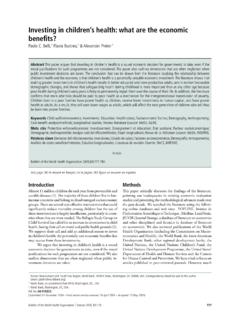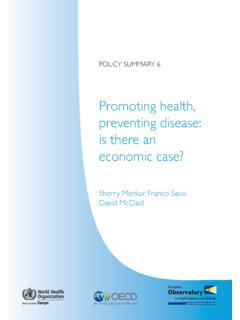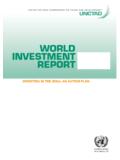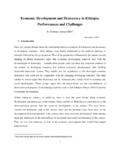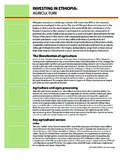Transcription of INVESTING IN HEALTH FOR ECONOMIC DEVELOPMENT
1 The Demographic Nexus INVESTING IN HEALTH FOR. ECONOMIC DEVELOPMENT . Executive Summary Version for Consultation and Comments 1. INVESTING IN HEALTH FOR ECONOMIC DEVELOPMENT . Report by the Mexican Commission on Macroeconomics and HEALTH First edition 2004. Universidad de las Am ricas, Puebla Santa Catarina M rtir, Cholula, 72820 Puebla, M xico Copyrigth 2004. Printed in Mexico ISBN 968-6254-66-8. 2. The Demographic Nexus NOTE FOR READERS. The Mexican Commission on Macroeconomics and HEALTH was created on July 29th, 2002 by the initiative of the Minister of HEALTH of Mexico, Julio Frenk. The Commission includes experts from academic institutions, the government, civil society and the private sector. Based on their professional experience, these experts have been able to analyze and reflect upon the link between HEALTH and ECONOMIC DEVELOPMENT .
2 The current edition of the Commission's Report, entitled Macroeconomics and HEALTH : INVESTING in HEALTH for ECONOMIC DEVELOPMENT , is meant for dialogue with a broad range of actors, (which will take place between November 2004 and February 2005) with the purpose of creating a consensus in terms of goals, process and outcomes. This Executive Summary presents a synthesis of the Commission's analysis, conclusions and recommendations. Those who wish to make comments via e-mail can send them to In order to keep the document short, this Executive Summary does not include the list of background papers or references. They can, however, be found in the complete Report also available at the following web page: It is my sincere hope, that the reader will find this Executive Summary of interest and utility.
3 Nora Lustig President of the Mexican Commission on Macroeconomics and HEALTH 3. INVESTING IN HEALTH FOR ECONOMIC DEVELOPMENT . Report by the Mexican Commission on Macroeconomics and HEALTH Copies of this publication can be requested from: Instituto de Pol ticas P blicas y Estudios del Desarrollo (IPD). Universidad de las Am ricas, Puebla Santa Catarina M rtir, Cholula 72820, Puebla Tel.: 52 222 229 2000 Ext. 4583, 4578. Fax: 52 222 229 2270. e-mail: 4. The Demographic Nexus TABLE OF CONTENTS. p g. Preface 7. Acknowledgements 11. Introduction 12. I. HEALTH and ECONOMIC Growth 15. II. HEALTH and Poverty Traps 18. III. What HEALTH Goals Should Be Chosen for Mexico? 22. IV. Are we INVESTING Well in HEALTH ? 29.
4 V. Social Protection for Everyone? 38. VI. Public Goods for HEALTH 42. VII. Conclusions and Recommendations 48. TABLES AND FIGURES. Table 1 Human DEVELOPMENT Index (HDI) for Different Regions 26. of Mexico in 2002. Table 2 HEALTH System Performance Indicators for a Selection of Countries 33. Table 3 Inventory of Public Goods in HEALTH 44. Table 4 Mechanisms for the Creation of Public Goods 45. Figure 1 Intergenerational Cycle of Human Capital Formation 17. Figure 2 Breakdown of HEALTH Expenditure, 2001 31. Figure 3 Distribution of Social Expenditure by Income Decil, 2002 34. Figure 4 Concentration Coefficients of Public Expenditure on HEALTH and Nutrition, 2000-2002 35. Figure 5 Coverage of Oportunidades and Access to Social Security, 39.
5 Mexico 5. INVESTING IN HEALTH FOR ECONOMIC DEVELOPMENT . Report by the Mexican Commission on Macroeconomics and HEALTH 6. The Demographic Nexus PREFACE. The Commission on Macroeconomics and HEALTH (CMH) was created in January 2000. as an initiative launched by the World HEALTH Organization (WHO) and chaired by the economist Jeffrey Sachs. This Commission's Report was published on December 20th, 2001. The CMH's main objective was to identify the importance of improving HEALTH standards and to calculate additional resources as well as necessary actions on a national and international level in order to promote ECONOMIC DEVELOPMENT . Its attention was focused on the countries that are unable to advance on their own and for which international aid is essential.
6 In the case of middle-income countries, the CMH stated the following: In most middle-income countries, average HEALTH spending per person is already adequate to ensure universal coverage for essential interventions. Yet such coverage does not reach many of the poor. Exclusion is often concentrated by region ( , rural western China and rural northeast Brazil), or among ethnic and racial minorities. For whatever reason, public-sector spending on HEALTH does not attend sufficiently to the needs of the poor. Moreover, since many middle-income countries provide inadequate financial protection for large portions of their population, catastrophic medical expenses impoverish many households. In view of the adverse consequences of ill HEALTH on overall ECONOMIC DEVELOPMENT and poverty reduction, we strongly urge the middle-income countries to undertake fiscal and organizational reforms to ensure universal coverage for priority HEALTH We also believe that the World Bank and the regional DEVELOPMENT banks, through nonconcessional financing, can help these countries to make a multi-year transition to universal coverage for essential HEALTH Additionally, the CMH suggested the creation of similar commissions on a national level.
7 On the basis of this recommendation, the Minister of HEALTH of Mexico, Dr. Julio Frenk established the Mexican Commission on Macroeconomics and HEALTH 1. Macroeconomics and HEALTH : INVESTING in HEALTH for ECONOMIC DEVELOPMENT , Report of the Commission on Macroeconomics and HEALTH , WHO 2001. 7. INVESTING IN HEALTH FOR ECONOMIC DEVELOPMENT . Report by the Mexican Commission on Macroeconomics and HEALTH (MCMH) on July 29th, 2002. The thirty-member Commission includes experts from academic institutions, the government, civil society and the private sector. Due to their professional experience, these experts have been able to analyze and reflect upon the link between HEALTH and ECONOMIC DEVELOPMENT . The Commission's mandate consists of 1) analyzing the relationship between INVESTING in HEALTH and the ECONOMIC DEVELOPMENT of Mexico; 2) evaluating the extent to which advances have been made in HEALTH indicators in our country, the characteristics of Mexico's investment in HEALTH (specifically, the level, distribution and the share dedicated to public goods) and the system of social protection against adverse HEALTH shocks; and 3) proposing actions and initiatives, specifically in the realm of public policy, in order to reap benefits for ECONOMIC DEVELOPMENT and poverty reduction.
8 Unlike other more frequent studies, the Commission's emphasis is on HEALTH as one of the fundamental determinants of ECONOMIC growth and poverty reduction. The positive impact that HEALTH has on growth and poverty reduction occurs through a number of mechanisms, such as through a reduction of production losses due to fewer worker illnesses, the increased productivity of adults as a result of better nutrition, lower absenteeism rates and improved learning among school children. This relationship also allows for the use of resources that had been totally or partially inaccessible due to illnesses. Finally, it allows for an alternative use of financial resources that might normally be destined for the treatment of ill HEALTH .
9 One of the assumptions of this Report is that DEVELOPMENT and per capita income levels in Mexico are high enough to potentially ensure proper HEALTH levels for the entire population. Mexico is a relatively rich country compared to countries in Africa, Asia and other parts of Latin America. Nevertheless, there are areas in the country where HEALTH indicators are similar to those found in much poorer countries. For reasons that will not be included in this Report, the situation in terms of HEALTH is one of stark contrast between regions and socioeconomic groups. Given this, the main objective of public policies related to HEALTH in the coming years must be that all regions and socioeconomic groups in Mexico achieve socially acceptable (and financially feasible) HEALTH indicators.
10 This way, policies can contribute to poverty reduction and create more dynamic and sustainable ECONOMIC growth. In Mexico, as in other middle-income countries with high inequality, the Millennium DEVELOPMENT Goals must explicitly include the reduction of the large gaps in HEALTH indicators between poor and nonpoor regions of the country. Through a relatively modest financial effort and, more importantly, through the effective use of existing resources, Mexico could improve the situation of less- developed regions and groups. According to World Bank estimates, for countries in developing or middle-income countries with institutions of an acceptable quality, a 10% increase in public HEALTH expenditures as a proportion of the Gross Domestic 8.











